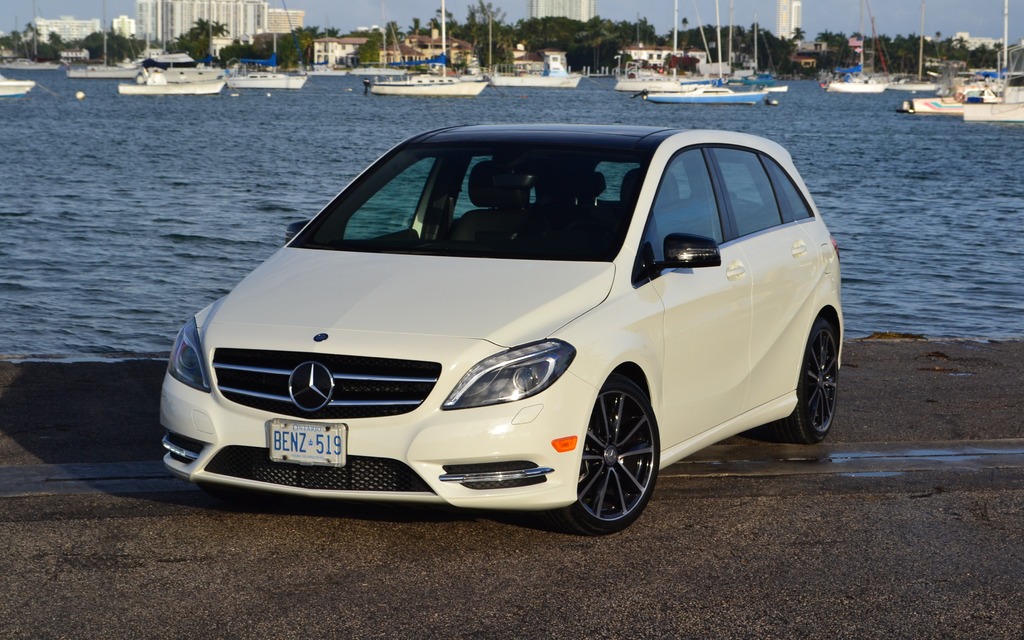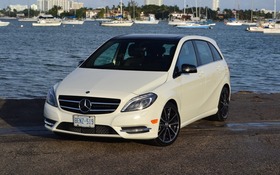2013 Mercedes-Benz B-Class: Compact luxury and power

| Strong points |
|
|---|---|
| Weak points |
|
The Mercedes-Benz B-Class has been offered in Canada since 2006, and its second-generation arrives this month at dealerships. Forget everything you know about the previous B-Class though, because the car has undergone a complete transformation. This little luxury compact whose only true rivals are the Audi A3 and the Lexus CT has taken a big step forward.
The B-Class returns to showrooms after a one-year absence. This new generation was introduced in Europe last year, but Mercedes-Benz preferred to keep America waiting for a year, knowing that the 2013 model would get a brand new engine that is much more suitable for our continent.
New turbo engine
The gas-powered engine offered in Europe wasn’t powerful enough. Plus, it would have been too complicated – and more expensive – to use their diesel engines. So, 2013 marks the arrival of an original engine used in the B250 for the first time in North America. This 2.0-litre four-cylinder turbocharged engine develops 208 horsepower and 258 lbs.-ft. of torque, which is a great deal of juice for a car in this category. To maximize fuel economy, they’ve included Start/Stop technology that automatically shuts off the engine at stops and starts it up again when it’s time to go again. The only potential drawback with this engine is that it runs on super, meaning it’ll cost you more at the pump.
The most attractive mechanical feature is undoubtedly the addition of a 7G-DCT seven-speed dual-clutch transmission. There’s nothing to be disappointed about here – forget about the unpleasant CVT gearboxes whose only advantage is fuel economy. Mercedes-Benz wasn’t taken in by the lure of the CVT, opting instead for a technological and efficient choice. So good is this transmission that we can forgive the manufacturer for not offering a manual gearbox.
A more masculine style
In terms of size, the 2013 B-Class is not as high (47 mm), but wider (12 mm) and longer (86 mm) than the old version. This represents a drastic change to its dimensions and is what gives it its new, much less “minivan-esque” style. Furthermore, let’s tell it like it is: the B-Class appealed much more to women than to men. This new generation will surely have a little more widespread appeal.
Its design resembles that of a small family car, like the Toyota Matrix, with its very practical and extremely popular configuration here in Canada. At the back, its lines have been modernized and made more similar overall to the manufacturer’s other models. In fact, seen from the back, many associate it with the R-Class (disappeared this year). The B is even nicer when it’s equipped with the Sport Package that, for $2,000, adds a plethora of interesting elements, such as the 18-inch rims and brake calipers that bear the M-B logo.
You really notice that you’re in a Mercedes-Benz once you’re inside. The previous generation’s plain and lifeless dashboard makes way for a rich and modern passenger compartment.Meticulous attention was paid to detail, assembly and quality of materials. We like the style of the air vents, as it’s reminiscent of those in the SLS. The multifunction screen located in the centre looks like an iPad mounted on the dashboard, but it doesn’t have a touch screen. Regrettably, you’ll have to use the rotary dial located on the console to control the various functions. And there’s adequate space for all passengers. The large liftgate facilitates loading the vehicle and the configuration of the cargo space can be adjusted according to your needs.
On the road
Once you’re behind the wheel, you’ll quickly find a good driving position. Unless you go for the Memory Package, you’ll have to rely on the manual controls to set your position, which is strange for a Mercedes-Benz. Visibility is excellent, thanks to the car’s numerous windows. And you’ll feel at ease, too, mainly because of the comfort of the seats and the feel of the sport steering wheel. In this regard, the Germans know what they’re doing.
The 208-horsepower turbo engine delivers respectable power without any real lag, provided you aren’t driving in Eco mode, which favours fuel economy and reduces the enthusiasm of the accelerator. To truly appreciate the car’s performances, you’ll need to drive in Sport mode. Put the pedal to the metal and the car goes 0-100 km/hr in 6.8 seconds. That’s better than the Volkswagen Golf GTI that, with its 200-hp engine, needed 6.9 seconds to cover the same distance. Equipped with the Sport Package, it handles much more dynamically due to its firmer suspension and its 18-inch wheels fitted with low-profile tires. It feels agile and responsive.
In the ordinary version, the B-Class offers a good mixture of a comfortable and dynamic ride. As for the lack of precision of the power steering, the adverse effect isn’t too pronounced and it gives you the impression of being in control. Basically, in buying the smallest Mercedes-Benz, you don’t have to sacrifice too much performance or driving pleasure.
The safety of other Mercedes-Benz models
You’d think that the manufacturer would want to save its technological gems for its much more expensive models and that by getting this mini Mercedes-Benz, you’d be getting a car without any gadgets. But this simply isn’t the case. The B-Class proposes a glut of systems from its great sedans, notably Collision Prevent Assist, a radar system that keeps an eye on the vehicles in front, warns you of possible collisions and prepares a variety of reactions including assisted emergency braking.
Offered at a base price of just under $30,000, you’ll definitely have to add the Premium Package ($2,650) that includes features like automatic climate control, heated seats and a panoramic sunroof. Many will also be taken with its Sport Package ($2,000), which will end up increasing the total cost to a little more than $35,000, but that that price, the equipment list is much more attractive than the base version.











